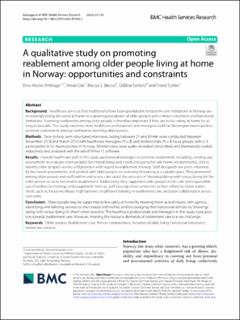| dc.contributor.author | Ambugo, E. A. | |
| dc.contributor.author | Dar, I. | |
| dc.contributor.author | Bikova, M. S. | |
| dc.contributor.author | Førland, O. | |
| dc.contributor.author | Tjerbo, T. | |
| dc.date.accessioned | 2023-10-05T08:22:40Z | |
| dc.date.available | 2023-10-05T08:22:40Z | |
| dc.date.issued | 2022 | |
| dc.identifier.citation | Ambugo, E. A., Dar, I., Bikova, M. S., Førland, O., & Tjerbo, T. (2022). A qualitative study on promoting reablement among older people living at home in Norway: opportunities and constraints. BMC health services research, 22(1), 150. | en_US |
| dc.identifier.uri | https://hdl.handle.net/11250/3094371 | |
| dc.description.abstract | Background
Healthcare services that traditionally have been provided in long-term care institutions in Norway are increasingly being delivered at home to a growing population of older people with chronic conditions and functional limitations. Fostering reablement among older people is therefore important if they are to live safety at home for as long as possible. This study examines how healthcare professionals and managers (staff) in Norwegian municipalities promote reablement among community-dwelling older people.
Methods
Face-to-face, semi-structured interviews lasting between 21 and 89 min were conducted between November 2018 and March 2019 with healthcare managers (N = 8) and professionals (N = 8 focus groups with 2–5 participants) in six municipalities in Norway. All interviews were audio-recorded, transcribed, and thematically coded inductively and analyzed with the aid of NVivo 12 software.
Results
Overall, healthcare staff in this study used several strategies to promote reablement, including: carrying out assessments to evaluate older people’s functional status and needs (including for safe home environments), and to identify older people’s wishes and priorities with regard to reablement training. Staff designed care plans informed by the needs assessments, and worked with older people on reablement training at a suitable pace. They promoted among older people and staff (within and across care-units) the principle of ‘showing/doing with’ versus ‘doing for’ the older person so as to not enable disablement. Additionally, they supported older people in the safe and responsible use of welfare technology and equipment. Even so, staff also reported constraints to their efforts to foster reablement, such as: heavy workload, high turnover, insufficient training in reablement care, and poor collaboration across care-units.
Conclusion
Older people may be supported to live safely at home by meeting them as individuals with agency, identifying and tailoring services to their needs and wishes, and encouraging their functional abilities by ‘showing/doing with’ versus ‘doing for them’ when possible. The healthcare professionals and managers in this study were positive towards reablement care. However, meeting the resource demands of reablement care is a key challenge. | en_US |
| dc.publisher | BMC health services research | en_US |
| dc.rights | Navngivelse 4.0 Internasjonal | * |
| dc.rights.uri | http://creativecommons.org/licenses/by/4.0/deed.no | * |
| dc.subject | older people | en_US |
| dc.subject | reablement care | en_US |
| dc.subject | person-centeredness | en_US |
| dc.subject | activities of daily living | en_US |
| dc.subject | functional limitations | en_US |
| dc.subject | homecare services | en_US |
| dc.title | A qualitative study on promoting reablement among older people living at home in Norway: opportunities and constraints | en_US |
| dc.type | Journal article | en_US |
| dc.source.volume | 22 | en_US |
| dc.source.journal | BMC health services research | en_US |
| dc.source.issue | 1 | en_US |
| dc.identifier.doi | https://doi.org/10.1186/s12913-022-07543-z | |
| dc.source.articlenumber | 150 | en_US |

